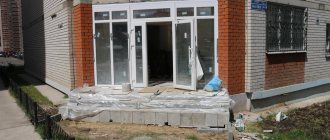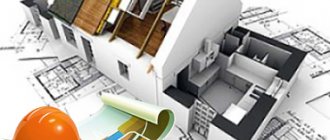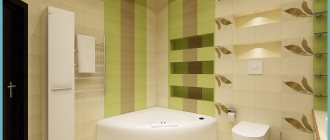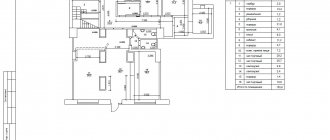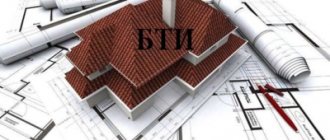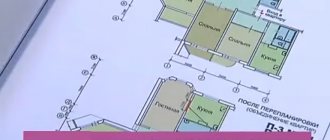First of all, let's give a definition. Legitimizing the redevelopment of non-residential premises means either obtaining permits from the Housing Inspectorate for premises built-in and attached to a residential building, or immediately obtaining BTI plans for premises located in a non-residential building.
Certificate of completed redevelopment. (indicates that the redevelopment is legalized).
The price of legalizing the redevelopment of non-residential premises.
Such a room can be built-in or attached to a residential building, or it can be located in a non-residential building. This greatly affects the cost of legalizing the redevelopment of non-residential premises and the procedure itself. Also, the price is determined by the type of activities performed, the footage of the object and other factors. To clarify the cost of your case and receive a commercial offer, call us at 8-495-507-74-67 or send to our email address any plan of the premises in question before and after the reconstruction. We will definitely answer you!
Cost and terms of approval
Let’s summarize, we’ll tell you how much it costs to approve a redevelopment and in what time frame you can obtain the necessary documents:
- the timing and cost of measurements, project preparation and technical conclusions depend on the complexity and volume of work (prices and timing will be determined after studying the documentation);
- review of documents at MZhI is free for up to 45 days (there is no fee for review at MZhI, and the cost of services is agreed upon at all stages, you can check the gender by calling MosOblReg);
- approval by the KGA is free, within 30 days;
- the timing and cost of producing a technical plan are determined by the terms of the contract with a cadastral engineer (the price will depend on the urgency and complexity of the work);
- Cadastral registration is carried out free of charge, up to 5 days in Rosreestr and up to 7 days through the MFC.
You can find out how much it costs to develop and approve documents from our specialists. Preliminary prices for services and examples of previous work can be found on our website.
How to legalize the redevelopment of non-residential premises in Moscow? Apartment house.
Legalized layout from the technical report.
Here we will analyze the process of legitimizing the redevelopment of non-residential premises built into a residential building or attached to it, if the redevelopment has already been completed. If the repair is just planned, then we discussed the process of approving it in this article.
Previously, if the repair had already been carried out, but was not recorded with red lines in the BTI documents, then you could try to approve it as planned. This change in layout was not tracked using any documents. At the same time, the facades should not have been affected, the change of which must be agreed upon with the Moskomarkhitektura, and a specialist comes out from there and immediately records the current situation: have they been changed or not yet, and the completed redevelopment was immediately “exposed.” Now it is also possible that even if the redevelopment is not noted in the BTI and the facades are not affected, an inspector from the Housing Inspectorate can selectively visit the site, where documents are submitted for approval, and check whether the redevelopment has been completed or not. Therefore, such a “loophole”, which allowed us to avoid a fine and a number of other troubles that we will not write about here, is becoming more and more elusive.
1.1. Let us consider step by step the procedure for legitimizing the redevelopment of non-residential premises.
Step 1.
BTI plan of non-residential premises in red lines.
So, if the reconstruction has already been carried out, then the first thing you need to do is get the BTI plans and an explanation in the red lines. These lines show which elements have been changed in the room. However, the dismantled structures are not shown in them, and therefore, in order to understand what the layout was in the room before the renovation, you need to order another plan and explication of the BTI before the redevelopment.
You can order them at any branch of the Bureau of Technical Inventory (BTI). We wrote more about BTI's plans here. A technician will come to the site and re-measure the room. Before calling a technician, we strongly recommend that you consult with specialists (you can contact us) about the work performed to find out whether they have violated any standards, of which there are quite a few. Otherwise, the BTI technician will mark them with red lines on the floor plan and the violations cannot then be legitimized. To avoid this, you need to prepare the room for the arrival of the technician,
Step 2.
Clause 18 Appendix No. 1 of the Resolution of the Moscow Government No. 508 allows for the already completed repairs of non-residential premises to be legalized according to a technical report (TZK) developed by a company that has the necessary permission from a Self-Regulatory Organization for this type of work. Therefore, it is necessary to order such a technical report from a specialized company (possibly from us). Let us note that if during the repair the load-bearing elements of the building were affected, then such a technical report must be ordered from the company that is the developer of the project for this house. If the developer is unknown, then the conclusion should be ordered from the State Budgetary Institution “Expert Center”. The simplest work, not listed in paragraphs 2 and 3 of Appendix 1 of PPM No. 508, for redevelopment without affecting facades, load-bearing walls, wet areas, entrance areas, etc., can be coordinated according to the sketch in accordance with paragraph 21 of the Appendix. No. 1 PPM No. 508, but such redevelopments are extremely rare.
Step 3.
Clauses 1.3 and 2.5.1.1.2 Appendix. No. 2 PPM No. 508 say that in order to legitimize the redevelopment of non-residential premises in Moscow, the necessary documents are submitted electronically to the Moscow Housing Inspectorate on the City Services Portal:
- request. It is issued directly on the State Services Portal;
- technical report (or sketch). It must be certified by an electronic signature of the organization that performed it.
- in accordance with clause 1.6 of the Appendix. 3 PPM No. 508 conclusion of the “Center for Hygiene and Epidemiology” at the fuel filling complex;
- extract from the Unified State Register of Real Estate;
- OGRN;
- a document confirming the right to act on behalf of a legal entity;
- charter of a legal entity; order approving the head of a legal entity;
- Bank details; BTI plan before and after reconstruction, as well as explications;
- forms 1a and 5 from BTI;
- certificates of inspection of hidden work;
- work log if load-bearing elements were affected;
Conclusion of the Center for Hygiene and Epidemiology.
Sometimes it is necessary to submit additional documents: - for example, minutes of the general meeting of residents of the house, if common property was affected during the renovation; - drawing up a conclusion from the Department of Underground Structures, if the adjacent area with a recess into the ground of more than 30 cm is affected; - etc. It is impossible to consider all possible cases in one article. If documents are submitted from an individual rather than a legal entity, then it is necessary to provide the same documents with the exception of those that relate to legal entities. If the facades were affected during the renovation, then the technical report is supplemented with photomontages and drawings before and after the redevelopment, which the MosZhilinspektsiya sends for approval to the Moskomarkhitektura. Until recently, paragraph 19 (1) of the App. No. 1 to PPM No. 508 did not allow approval of the already completed redevelopment of facades. Now, with the release of paragraph 20 of the same Appendix on August 19, 2021, this was allowed until January 1, 2021.
Step 4.
Upon a voiced request, an inspector from the Housing Inspectorate comes to the site and checks the actual layout with that specified in the technical report. Further, in accordance with paragraph 18 of the App. No. 1 PPM No. 508, he draws up a protocol on an administrative violation, since the reconstruction was carried out without permission, and sets a fine. According to paragraph 2 of Article 7.21 of the Code of Administrative Offenses of the Russian Federation, individuals must pay 2000-2500 rubles, and legal entities - 40-50,000 rubles. To avoid such a fine in the second case, you can enter into a lease agreement with an individual and submit documents from him. After paying the fine, if the redevelopment does not violate any norms and coincides with the technical conclusion, then the inspector issues a certificate of completed redevelopment. He sends one copy to the BTI.
Step 5.
Now, with the act in hand, you need to contact the BTI again to call a technician to measure the premises. He measures the room and prepares a BTI plan and an explanation without red lines.
Step 6.
Based on the documents received, a technical plan is ordered from the cadastral engineer and submitted to the MFC for Rosreestr, so that their employees correct the data on the premises in the Unified State Register.
Legal requirements, responsibility
There are certain rules and regulations, compliance with which during the redevelopment process is mandatory, these are:
• regulatory requirements;
• building regulations;
• sanitary and hygienic standards.
Thus, planned changes require confirmation from several authorities at once, which means you will have to take care of obtaining permits yourself or resort to the help of structures that provide similar services (for example, design companies)
. Legal redevelopment, as well as the involvement of qualified specialists, is a guarantee that the premises will not fall into disrepair as a result of unprofessional or thoughtless actions, and any risks will be minimized.
If unpleasant surprises occur
(destruction or weakening of the building's load-bearing structures), the organization that issued the permit will be responsible , unless, of course, all work was carried out in strict accordance with the plan.
It is for this reason that, as practice shows, it is easier to obtain permits for small redevelopment of non-residential spaces than to obtain consent for large-scale changes.
How to legitimize the already completed redevelopment of non-residential premises? Non-residential building.
Now let's move on to considering non-residential detached buildings entirely or parts thereof. For them, by and large, it doesn’t matter whether the redevelopment has already been done or not yet. There is no Resolution in Moscow that would establish regulations for their legalization. Nobody issues fines here.
Therefore, a technical report and a redevelopment project are prepared in a design company with SRO approval. They are submitted to the BTI to order a plan and an explanation with measurements. A technician leaves the BTI and measures the object. If the layout coincides with that specified in the project, then BTI plans are issued with a new layout without red lines. However, there is one catch. Previously, in Moscow, changes in the facades of detached non-residential buildings, as well as for apartment buildings, were approved by the Moskomarkhitektura. Then these powers were removed from them, and a new organization was not appointed. Now it turns out that changing the facade of such a building is impossible to legitimize. In such a situation, Rosreestr refuses to enter new data into the Unified State Register of Real Estate. And BTI has now begun to draw red lines on the facades affected. A resolution of the Moscow Government should soon be issued, which will appoint an organization and determine the procedure for legitimizing the facades of individual non-residential buildings, but for now it is only possible to obtain black BTI lines for internal redevelopment. It is also important here that only redevelopment activities are carried out, and not reconstruction. Otherwise, you will have to obtain a construction permit in accordance with the Town Planning Code of the Russian Federation. The list of works not related to reconstruction is given in PPM No. 432. If only internal redevelopment has been carried out in a non-residential premises without reconstruction, then after receiving the BTI in the black lines, the cadastral engineer draws up a technical plan, which is submitted to record the changes in the Unified State Register.
How is redevelopment different from redevelopment or reconstruction?
Construction work on real estate can be carried out as part of redevelopment, reconstruction or reconstruction. Let us highlight the main characteristics of these types of work:
- redevelopment involves changing the configuration of the room;
- reconstruction includes changes in the location or characteristics of engineering, electrical and other networks, plumbing and other equipment;
- Reconstruction means changing the parameters of a building, its height, number of storeys, area, replacement or restoration of load-bearing structures.
Since reconstruction involves impacts on load-bearing structures and elements and may pose a threat to the integrity of the building, a building permit must be obtained to carry it out. The issuance of such a document is not within the competence of the Ministry of Housing, therefore, the reconstruction project must be addressed to the State Construction Supervision and Expertise Service of Moscow, the Committee for State Control, Use and Protection of Historical and Cultural Monuments of Moscow (if the house is classified in this category).
Expert commentary . As part of the reconstruction, work may be carried out that falls under the concept of redevelopment and reconstruction. Requirements for their implementation will be provided for in the reconstruction project. If you need to obtain permission for reconstruction, design documentation can be ordered from MosOblReg.
Examples of legalized redevelopment in non-residential premises.
3.1. Legalized redevelopment of non-residential premises in an apartment building.
BTI plan of non-residential premises in red lines.
Coordinated layout from the technical report.
In this example of a grocery store, the design of the entrance group and vestibule were legalized; dismantling and installation of non-load-bearing partitions, including the installation of wet zones.

